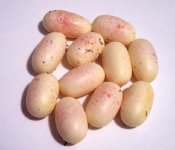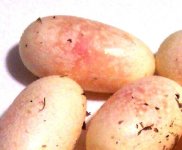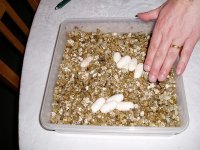This morning, I found that two of my females were double-clutching. I watched both females lay the last eggs of these clutches, so the photos below are of VERY freshly laid eggs.
One female laid a clutch of 11 eggs; the other laid a clutch of 6 eggs, 2 of which are clearly slugs (darker in color and slimy/wet feeling). The 11 eggs in the top left grouping are from one clutch; the four eggs on the lower right, along with the two slugs at the very bottom, are from the other clutch.
The eggs look different from both females' first clutches, which were completely normal (haven't hatched yet -- laid 5/19 and 5/20 -- but still look great). These new eggs (1) didn't stick together, although they were laid right next to each other, (2) feel dryish, unlike slugs and (3) have "pebbly" surfaces. Also, some have pinkish blotches, sorta veiny looking, and all seem much thinner shelled than regular eggs.
These are the things these females have in common:
1) A few days after laying their first clutches but before either had gone through post-lay sheds, I exposed both to 90-degree ambient temps for about 3-1/2 hours, in hopes of killing off any retained sperm from their first breedings (I wanted to breed both to a different male). I chose to expose them to heat before their post-lay sheds because I did not want to harm any follicles that might be present when they re-ovulated.
2) I bred both right after their post-lay sheds.
3) I bred both to the same male, who has not bred before this year.
Since the egg shells seem too thin, did I rebreed the females too soon after their first clutches, before they had enough time to replenish their supplies of calcium? These eggs were laid about 7-1/2 weeks after the first clutches.
Do these eggs look viable? I intend to incubate them, regardless, but I don't feel too hopeful. Has anyone had eggs like this that hatched OK?
One female laid a clutch of 11 eggs; the other laid a clutch of 6 eggs, 2 of which are clearly slugs (darker in color and slimy/wet feeling). The 11 eggs in the top left grouping are from one clutch; the four eggs on the lower right, along with the two slugs at the very bottom, are from the other clutch.
The eggs look different from both females' first clutches, which were completely normal (haven't hatched yet -- laid 5/19 and 5/20 -- but still look great). These new eggs (1) didn't stick together, although they were laid right next to each other, (2) feel dryish, unlike slugs and (3) have "pebbly" surfaces. Also, some have pinkish blotches, sorta veiny looking, and all seem much thinner shelled than regular eggs.
These are the things these females have in common:
1) A few days after laying their first clutches but before either had gone through post-lay sheds, I exposed both to 90-degree ambient temps for about 3-1/2 hours, in hopes of killing off any retained sperm from their first breedings (I wanted to breed both to a different male). I chose to expose them to heat before their post-lay sheds because I did not want to harm any follicles that might be present when they re-ovulated.
2) I bred both right after their post-lay sheds.
3) I bred both to the same male, who has not bred before this year.
Since the egg shells seem too thin, did I rebreed the females too soon after their first clutches, before they had enough time to replenish their supplies of calcium? These eggs were laid about 7-1/2 weeks after the first clutches.
Do these eggs look viable? I intend to incubate them, regardless, but I don't feel too hopeful. Has anyone had eggs like this that hatched OK?






